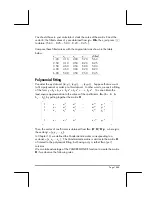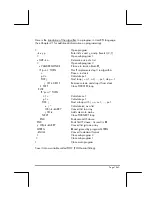
Page 19-3
As the decimal (DEC) system has 10 digits (0,1,2,3,4,5,6,7,8,9), the
hexadecimal (HEX) system has 16 digits (0,1,2,3,4,5,6,7,8,9,A,B,C,D,E,F),
the octal (OCT) system has 8 digits (0,1,2,3,4,5,6,7), and the binary (BIN)
system has only 2 digits (0,1).
Conversion between number systems
Whatever the number system selected, it is referred to as the binary system for
the purpose of using the functions R
B and B
R. For example, if
@HEX
!
is
selected, the function B
R will convert any hexadecimal number (preceded
by #) into a decimal number, while the function R
B works in the opposite
direction. Try the following exercises, HEX is the current base:
The following examples show conversions when the base is the octal system:
We also present transformations using the binary system as the current base:
Notice that every time you enter a number starting with #, you get as the entry
the number you entered preceded by # and followed by the letter h, o, or b
(hexadecimal, octal, or binary). The type of letter used as suffix depends on
which non-decimal number system has been selected, i.e., HEX, OCT, or BIN.
















































